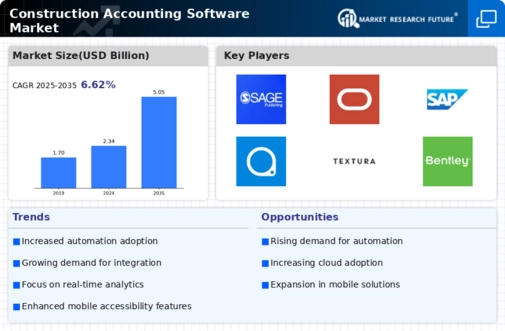Market Growth Projections
The Global Construction Accounting Software Market Industry is poised for substantial growth, with projections indicating a rise from 2.34 USD Billion in 2024 to 5.05 USD Billion by 2035. This growth trajectory suggests a compound annual growth rate (CAGR) of 7.26% from 2025 to 2035. Such figures underscore the increasing reliance on technology-driven solutions within the construction sector. As firms continue to adopt advanced accounting software, the market is likely to witness innovations that enhance financial management capabilities, thereby supporting the industry's overall growth.
Regulatory Compliance and Reporting
Regulatory compliance remains a pivotal driver within the Global Construction Accounting Software Market Industry. As governments worldwide impose stricter financial regulations and reporting standards, construction firms must adopt robust accounting solutions to ensure compliance. This trend is particularly evident in regions with complex tax structures and labor laws. Software that automates compliance processes not only mitigates risks associated with non-compliance but also enhances transparency and accountability. Consequently, firms are increasingly investing in construction accounting software to navigate regulatory challenges effectively, thereby contributing to the market's anticipated growth.
Increased Demand for Project Efficiency
The Global Construction Accounting Software Market Industry experiences heightened demand for project efficiency as construction firms seek to streamline operations and reduce costs. With the industry projected to reach 2.34 USD Billion in 2024, companies are increasingly adopting software solutions that enhance financial management, budgeting, and reporting. These tools enable real-time tracking of expenses and resource allocation, which is crucial for maintaining profitability in a competitive landscape. As firms strive to complete projects on time and within budget, the integration of advanced accounting software becomes essential for achieving operational excellence.
Expansion of the Construction Sector Globally
The expansion of the construction sector globally serves as a crucial driver for the Global Construction Accounting Software Market Industry. With increasing urbanization and infrastructure development, the demand for construction services is on the rise. This growth necessitates sophisticated accounting solutions to manage the financial complexities associated with large-scale projects. As the industry evolves, firms are recognizing the importance of integrating accounting software to handle diverse financial operations efficiently. The anticipated growth trajectory, with a CAGR of 7.26% from 2025 to 2035, reflects the sector's robust expansion and the corresponding need for advanced financial management tools.
Technological Advancements in Software Solutions
Technological advancements significantly influence the Global Construction Accounting Software Market Industry. Innovations such as cloud computing, artificial intelligence, and data analytics are transforming how construction firms manage their finances. These technologies facilitate real-time data access, predictive analytics, and enhanced collaboration among project stakeholders. As a result, firms can make informed decisions based on accurate financial insights. The ongoing evolution of software capabilities is expected to drive market growth, with projections indicating a rise to 5.05 USD Billion by 2035. This technological shift underscores the necessity for construction companies to adopt modern accounting solutions to remain competitive.
Growing Focus on Cost Control and Budget Management
Cost control and budget management are increasingly prioritized within the Global Construction Accounting Software Market Industry. As construction projects often face budget overruns, firms are turning to specialized accounting software to enhance financial oversight. These solutions provide tools for detailed budgeting, expense tracking, and variance analysis, enabling firms to identify potential financial pitfalls early in the project lifecycle. The emphasis on cost efficiency is likely to propel market growth, as firms seek to leverage software that not only tracks expenditures but also forecasts future financial performance, ensuring sustainable profitability.

















